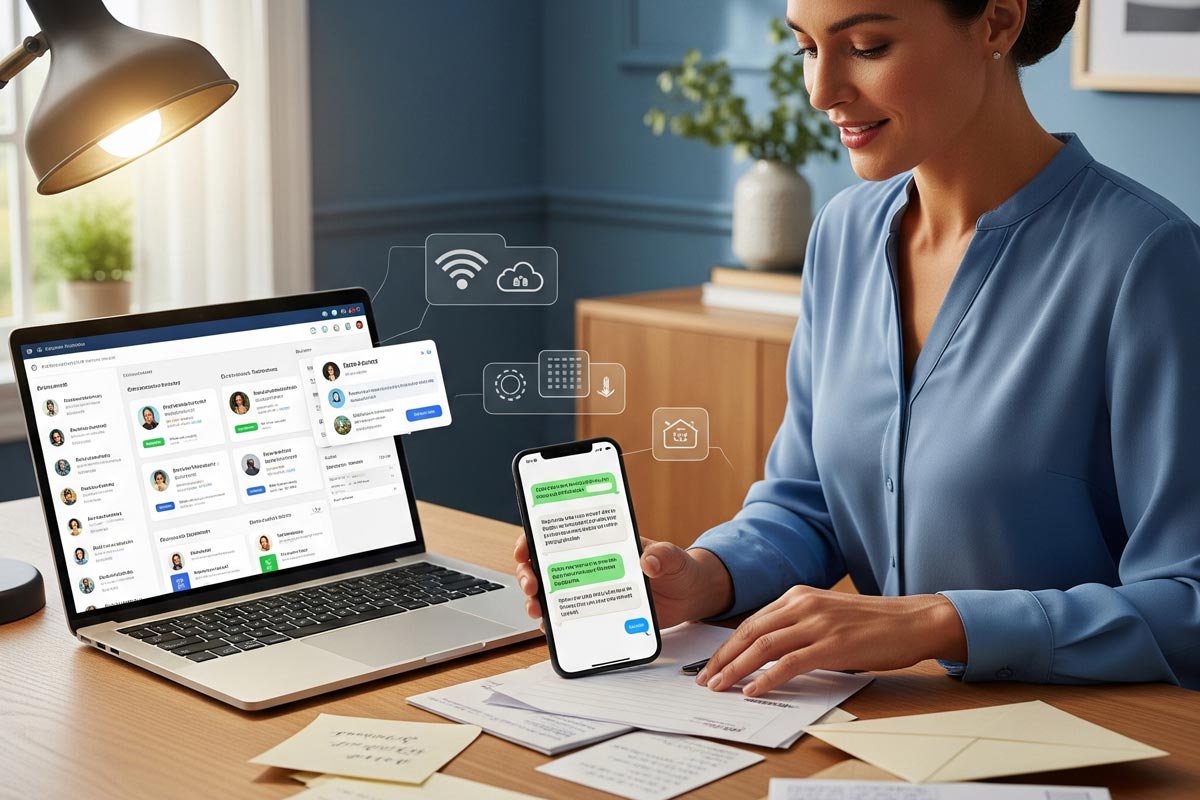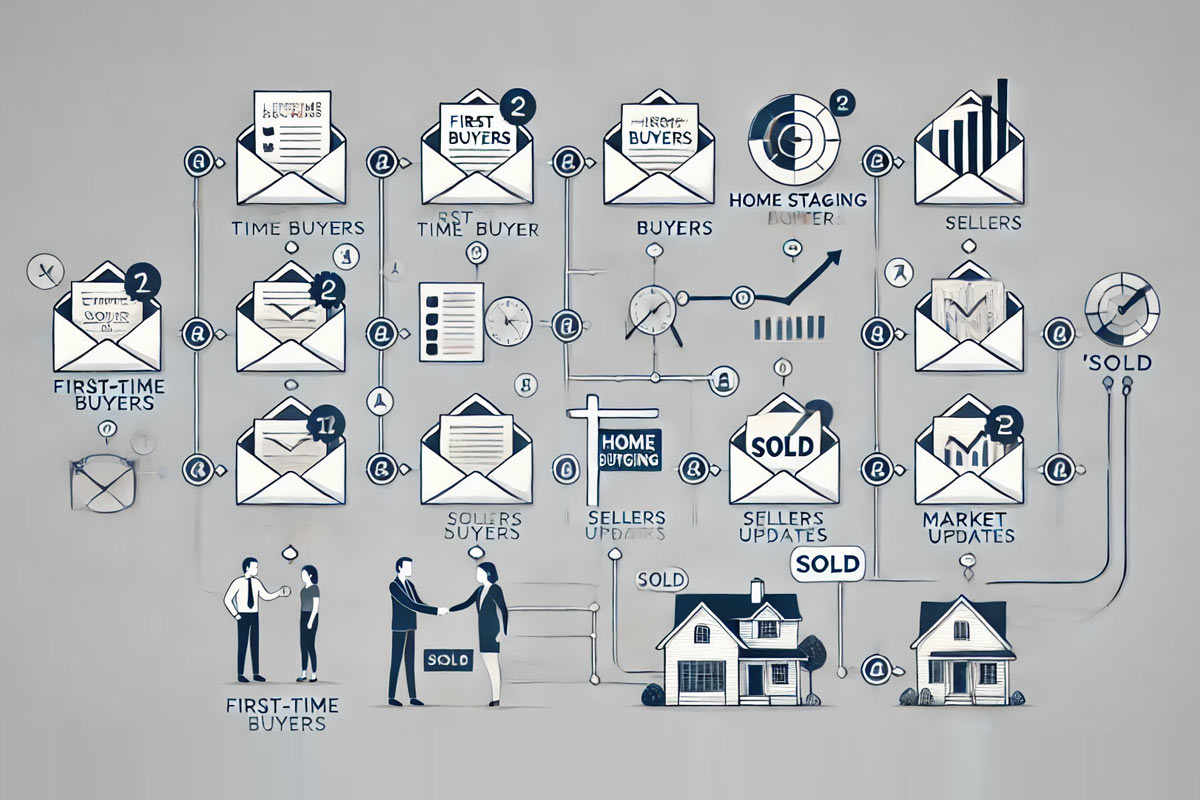
As a real estate agent, you might encounter the misconception that the holiday season is a slow time for selling homes. With people busy with festivities and travel, it's easy to assume that listing a Read more...
As a real estate agent, you might encounter the misconception that the holiday season is a slow time for selling homes. With people busy with festivities and travel, it's easy to assume that listing a property during this time could be challenging. But don't let that common belief deter you! The truth is, the holiday season offers unique advantages that you can leverage to benefit your clients. Let's debunk this myth and explore why listing during the holidays can be a winning strategy for you and your sellers.
Less Competition - Your LIsting Shines Even Brighter
As a real estate agent, you can use the reduced competition during the holidays to your advantage. Many sellers mistakenly believe it's a bad time to list, perhaps due to misconceptions or advice from those who haven't had the benefit of a quality real estate license school. This leads to lower inventory, with the National Association of Realtors reporting a 15% drop in listings in December compared to the spring selling season. This presents a golden opportunity for you. With fewer homes on the market, your listings are more likely to grab attention and attract serious buyers.
Serious Buyers - Ready to Make a Move
While there might be fewer buyers overall during the holidays, those actively searching tend to be highly motivated. These buyers often have specific needs or timelines driving their search, such as year-end tax breaks, job relocations, or a desire to settle into a new home before the new year. Their urgency can translate into quicker closings and better offers.
Holiday Spirit - Capture the Magic
As a real estate agent, you can capitalize on the inherent charm of the holiday season. Encourage your clients to enhance their home's appeal with tasteful decorations, festive lights, and even the enticing aroma of freshly baked cookies. This creates a warm and inviting atmosphere that resonates with potential buyers on an emotional level, making the property more memorable and desirable. To maximize this effect, suggest professional staging that incorporates festive touches while maintaining a clean and spacious feel. Also, work with your clients to ensure their listing photos highlight the cozy holiday ambiance without appearing cluttered. This will help your listings stand out and attract more interest.
Favorable Timing for Sellers - Minimize Disruption, Maximize Opportunity
As a real estate agent, remember to highlight the advantages of holiday listings for your clients. With fewer showings, they can enjoy the festivities with minimal disruption to their routines. Plus, if they're planning to buy in the spring market, selling now allows them to secure their next home before the competition heats up. This strategic timing, something you likely learned in your real estate license school, can give them a real advantage and provide a smoother transition.
Considerations Before Listing - Plan for Success
When advising clients about holiday listings, be sure to address potential challenges while emphasizing the overall benefits. Acknowledge that limited showing schedules due to holiday gatherings and travel might require flexibility. Reassure them that with careful planning and open communication, these obstacles can be easily managed.
Ultimately, position holiday listing as a strategic move. Highlight the unique opportunities it presents, from reduced competition and motivated buyers to the captivating allure of a festively decorated home. By guiding your clients through the dynamics of holiday home selling and implementing effective marketing strategies, you can increase their chances of a successful and timely sale, further solidifying your value as their trusted real estate advisor.
So, are you ready to embrace the holiday season as a prime time for real estate success? By understanding the unique dynamics of the market during this period, you can effectively guide your clients and turn the "slow" season into a win-win for everyone. Remember, a well-prepared agent is a successful agent, and a quality real estate license school can equip you with the knowledge and skills to thrive in any market condition.
Want to learn more about maximizing your potential in the real estate industry? Contact us today or visit our website to explore our comprehensive real estate training programs and discover how we can help you achieve your career goals.
Love,
Kartik
|

Your Blueprint for Referrals and Repeat Business
The moment you receive your real estate license marks the beginning, not the end, of your professional journey. While our real estate school teaches Read more...
Your Blueprint for Referrals and Repeat Business
The moment you receive your real estate license marks the beginning, not the end, of your professional journey. While our real estate school teaches you the fundamentals of property law and transaction mechanics, the true art of building a career centered on client retention lies in what happens after the closing.
In today's competitive market, the most successful agents understand a fundamental truth: relationships are a form of currency. The cost of acquiring a new client can be five to seven times higher than nurturing an existing one. Yet many agents, caught in the endless cycle of chasing new leads, overlook the goldmine sitting in their past client database. This shift from transactional thinking to cultivating luxury client relationships isn't just good karma—it's innovative business that generates consistent real estate referrals, repeat transactions, and a personal brand that stands the test of time.
For newer agents fresh out of real estate school, developing this client-centric mindset early establishes the foundation for long-term success. Seasoned brokers will find advanced strategies here to deepen existing relationships, particularly within luxury markets where discretion and personalization are paramount.
Mastering Client Engagement: Tech-Powered, Human-Centric
Forget the old days of just holiday cards. Today's top agents blend cutting-edge tech with authentic human connection to create systematic, personalized client touchpoints that scale.
Develop a tiered communication rhythm. In the first 30 days post-closing, check in weekly. These aren't sales calls; they're genuine inquiries about their move, new home, or local recommendations. As time goes on, these touchpoints become less frequent but more valuable, shifting from problem-solving to relationship-building.
Modern CRM systems like Follow Up Boss, Chime, or HubSpot, supercharge this process. They use AI to analyze client behavior, predict needs, and suggest optimal contact times. These platforms segment your database by transaction type, property value, communication preferences, and even life events. Imagine your CRM alerting you that a past client's child is nearing college age—perfect for discussing downsizing or investment properties. Tech handles the remembering and organizing, freeing you to focus on the human connection.
The real magic is when high-tech efficiency meets high-touch authenticity. Your CRM prompts the outreach, but the message should feel like it's from a friend.
Send a handwritten note within 48 hours of closing—it speaks volumes in our digital world. Mark home purchase anniversaries not with a generic email, but with a personalized video message showing their home's appreciation.
Creating Value Beyond the Transaction
Your digital presence should position you as a trusted advisor and community connector, not just another agent flooding social media with listing photos. Think about what your past clients need and want to know. They're not shopping for homes anymore—they're living in them. They're wondering when to refinance, how to maximize their home's value, which local contractor won't overcharge them, and where to find the best pizza in their new neighborhood.
This is where your content strategy becomes crucial:
Social Media Excellence: Share seasonal home maintenance tips that save them from costly repairs. Spotlight the local coffee shop owner who remembers everyone's order, or the family-run hardware store that still offers personalized service. Celebrate community events and milestones. When you position yourself as a curator of local knowledge and lifestyle enhancement, you remain valuable long after the sold sign comes down.
Newsletter Mastery: Your monthly newsletter shouldn't read like a market report designed for economists. Instead, translate those statistics into stories your clients care about. Rather than simply stating that home values increased 8%, explain what this means for their family's wealth-building journey. Include practical guides like "Five Weekend Projects That Add $10,000 to Your Home Value" or "The Hidden Gems of [Neighborhood Name] Only Locals Know About."
Website as Resource Hub: Transform your website from a listing showcase into a comprehensive resource center. Create downloadable seasonal maintenance guides, maintain a vetted vendor directory, and publish neighborhood insights that keep past clients returning for valuable information.
The Art of Memorable Client Appreciation
Moving beyond generic closing gifts requires understanding what creates lasting impressions. That standard gift basket gets regifted or forgotten, but the client who loves cooking will remember the private chef who prepared a gourmet meal in their new kitchen. The wine enthusiast will talk for years about the sommelier-led tasting you arranged at their housewarming. The family with young children will be touched by the custom treehouse plans you commissioned for their backyard oak.
These thoughtful gestures extend beyond closing day. When you learn through your ongoing conversations that a client received a promotion, send congratulations. When their child graduates, take a moment to acknowledge the milestone. When they mention training for their first marathon, surprise them with a gift certificate to the local running store. These moments of recognition build emotional equity that no competitor can match.
Creating exclusive experiences amplifies this effect exponentially. Your annual client appreciation event shouldn't feel like a networking mixer—it should feel like a reunion of friends. Some agents host summer barbecues in local parks where clients' kids play together while adults swap renovation stories. Others organize holiday cookie decorating parties that become cherished traditions.
For luxury clientele, discretion is paramount. Ensure your outreach respects their privacy, providing value without intrusion. The bar for experiences rises accordingly: private art gallery tours with the curator, sunset yacht cruises, or exclusive wine harvest experiences at boutique vineyards. The key to these events isn't their extravagance—it's their authenticity combined with impeccable attention to privacy preferences.
Building Your Referral Engine
The most successful agents never have to ask for referrals—they create experiences so remarkable that clients naturally want to share them. However, there's an art to facilitating this process without appearing pushy or transactional.
The best moments for referral conversations arise organically during your regular touchpoints. When a client expresses gratitude for your help resolving a post-sale issue, that's your cue. When they mention at your summer barbecue that their coworker is house-hunting, that's your opportunity.
Here's a simple script that works: "Thank you so much for your trust in working with me. If anyone you care about mentions real estate—whether buying, selling, or just curious about the market—I'd be honored if you'd pass along my contact information. I'm never too busy for your referrals."
Make referring effortless by providing these tools:
Digital business cards they can text instantly
Pre-written introduction emails like: "I wanted to connect you with [Your Name], who helped us find our dream home. They made the entire process smooth and stress-free, and I think you'd appreciate their approach."
Social media templates for sharing experiences
QR codes linking to your testimonial page
When legal and ethical, some agents enhance referral relationships through thoughtful incentives that strengthen bonds rather than create obligations. Consider donating to a client's favorite charity in their name as a reward for successful referrals or as a way to provide exclusive experiences, such as tickets to local cultural events. The key is to ensure that any incentive feels like a natural extension of your relationship, not a transaction.
Becoming the Indispensable Advisor
The transformation from a transaction-focused agent to a trusted advisor occurs when you expand your value proposition beyond buying and selling. Offer annual home equity reviews that help clients understand their growing wealth. Provide market updates contextualized to their investment strategies. Connect them with resources for renovations, refinancing, or navigating real estate implications of significant life changes.
Sarah, a luxury agent specializing in equestrian properties, exemplifies this approach perfectly. When clients close on horse properties, she doesn't just hand over keys—she delivers custom stable signs featuring their property name and includes a year's membership to the local riding club. Her monthly "Saddle Up" newsletter has become a must-read in the equestrian community, featuring regional event calendars, seasonal property maintenance tips tailored to horse facilities, and spotlights on trusted veterinarians and trainers.
But Sarah's genius lies in her "Equestrian Services Directory"—a carefully vetted list of providers from farriers to fence contractors, all offering preferred rates to her clients. She introduces each client to relevant providers, hosts quarterly "Boots & Bourbon" networking events at a local ranch, and has positioned herself as the hub of the luxury equestrian real estate community.
The result?
Sixty percent of her business comes from referrals and repeat clients; she commands premium commissions, and she has built a list of potential clients who seek her out specifically.
Measuring What Matters
Success in relationship-based real estate isn't measured solely in transaction volume. Here's how to track what truly matters:
Referral Rate: Aim for 20-30% of new business from past client referrals. Track this through your CRM by tagging lead sources and running quarterly reports to monitor progress.
Client Lifetime Value (CLV): Calculate total revenue per client relationship using this formula: Initial transaction commission + repeat transaction commissions + referral-generated commissions. Most CRMs can automatically generate these reports.
Repeat Business Rate: Monitor the percentage of clients who complete multiple transactions with you. Set up annual reviews in your CRM to track this metric over time.
Engagement Metrics: Use email marketing platforms to track open rates (target 25%+), click-through rates, and event RSVPs. Tools like Mailchimp or Constant Contact can provide detailed analytics.
Net Promoter Score (NPS): Send quarterly surveys using tools like SurveyMonkey or Google Forms, asking: "On a scale of 1-10, how likely are you to recommend me to a friend?" Scores of 9-10 indicate strong advocates.
These metrics tell a story far more valuable than monthly sales figures. They indicate whether you're building a sustainable practice or just churning through transactions.
Your Path Forward
Your real estate license opens doors, but your relationships determine how far you'll walk through them. In an industry where lots of agents fail within five years, those who thrive understand that each closed transaction isn't an ending—it's the beginning of a potentially lifelong professional relationship.
The lessons from our real estate school lay the foundation, but applying these relationship strategies truly builds the skyscraper of your career. This approach requires a fundamental mindset shift. Instead of viewing your database as a list of past clients, see them as your professional community. Instead of measuring success by the number of new leads generated, measure it by the relationships deepened. Instead of chasing the next transaction, invest in creating such remarkable experiences that transactions naturally follow.
The choice is yours: continue the exhausting chase for cold leads, or invest in the warm relationships already in your sphere. Your future success in real estate isn't determined by how many people you meet—it's defined by how many relationships you nurture.
Take a moment today to revisit your past client list. Identify five clients to reconnect with this week—perhaps send a handwritten note, share a relevant market update, or check in on how they're enjoying their home. Your future business depends on these small but significant actions.
Love,
Kartik
|

From Classroom to Closing – ADHI Schools’ Playbook for New Agents Who Want to Win Early
Nearly every rookie in real estate believes success comes down to “working hard.” Yet industry numbers Read more...
From Classroom to Closing – ADHI Schools’ Playbook for New Agents Who Want to Win Early
Nearly every rookie in real estate believes success comes down to “working hard.” Yet industry numbers show that only a small portion of real estate licensees ever break into the top-earner tier. What’s the real difference? Top producers follow a systematic, six-pillar framework that blends discipline, strategy, and emotional intelligence. Below is that framework, rewritten for brand-new licensees and current ADHI Schools students so that you can plug it into your business on Day 1.
td {
padding: 20px;
font-weight: 500;
border: 1px solid gray !important;
border-style: dashed !important;
}
th {
padding: 20px;
text-align: center !important;
border: 1px solid gray !important;
border-style: dashed !important;
}
table {
border-collapse: collapse;
border: 1px solid gray !important;
border-style: dashed !important;
border-collapse: collapse !important;
}
@media (max-width: 428px) {
.table-wrapper{
max-width: 100%;
overflow: scroll;
}
}
1. Prospecting Power Hour
|

Generating real estate leads can feel overwhelming, but did you know that you can generate business without solely relying on online ads. By focusing on real estate networking and building your referral Read more...
Generating real estate leads can feel overwhelming, but did you know that you can generate business without solely relying on online ads. By focusing on real estate networking and building your referral program, you can strengthen your real estate business through genuine connections. In-person meetings, community involvement, and strong relationships with centers of influence are crucial in generating real estate leads and creating a steady flow of clients. These personal connections will help you become a local expert on home values and market trends.
Mastering Real Estate Networking at Events
Attending local industry events, community fairs, and neighborhood gatherings is a proven way to attract real estate clients. The effectiveness of face-to-face interactions at these events allows you to build trust, stand out among other real estate agents, and ultimately generate leads that can turn into profitable referrals.
Prepare a Strong Elevator Pitch
Keep It Short: In 30 seconds, explain who you are, what you do, and who you help.
Highlight Your Specialty: If you’re a buyer’s agent specializing in first-time homebuyers or a seller’s agent focusing on property listings, mention it.
Example: “Hi, I’m Jane Smith, a local real estate agent helping first-time homebuyers navigate the market and find their dream homes.”
Make Meaningful Connections
Ask Questions: Inquire about their needs, such as buying a first home or exploring market trends in the area.
Listen Carefully: Show genuine interest, and offer a helpful tip about local home values or popular neighborhoods.
Quality Over Quantity: Focus on a few strong contacts rather than simply handing out dozens of business cards.
Follow Up Promptly
Send a Friendly Note: A short email or social media message referencing what you discussed.
Offer Value: Share a helpful article on local property listings or a guide to understanding market trends.
Build Trust Over Time: Consistent follow-ups turn a casual chat into a reliable referral source.
Building Relationships With Centers of Influence (COIs)
Centers of influence—like mortgage brokers, attorneys, and financial advisors—can guide their clients to you, helping you generate real estate leads with less effort. By forming strong connections with these trusted professionals, you gain access to their client base and raise your profile as a go-to real estate agent.
Tips for Working With COIs
Offer Value First: Refer a client needing a home loan to a dependable mortgage broker.
Frequent Contact: Set up monthly coffee meetings or send regular updates on home values, property listings, and local market trends.
Provide Useful Resources: Share guides on buying or selling homes, and keep them updated on zoning changes or community developments that influence real estate marketing.
Over time, your centers of influence will recognize you as a trustworthy partner who can handle their clients’ real estate needs.
Building a Strong Real Estate Referral Network
Cultivating a strong referral network is essential for sustained growth in the real estate business. It's about building genuine relationships and providing exceptional service that naturally encourages clients, friends, and family to recommend you. A well-structured system for nurturing these relationships can become a cornerstone of your marketing strategy, consistently generating valuable real estate leads.
Strategies for Encouraging Referrals:
Exceptional Client Service: The most powerful driver of referrals is providing outstanding service that exceeds client expectations. When clients are truly satisfied with their experience, they are naturally more inclined to recommend you to others. Focus on clear communication, proactive problem-solving, and going the extra mile.
Stay Top-of-Mind: Regularly connect with past clients through various touchpoints:
Personalized Check-ins: Send personalized emails, phone calls, or handwritten notes on anniversaries, birthdays, or other relevant occasions.
Valuable Content: Share helpful content such as market updates, home maintenance tips, or local community guides. This keeps you top-of-mind and positions you as a trusted resource.
Social Media Engagement: Engage with past clients on social media by liking, commenting, and sharing their posts. This helps maintain a connection without being overly intrusive.
Client Appreciation Events: Host client appreciation events, such as holiday gatherings, open house previews, or community events. These events provide opportunities to connect with past clients in a relaxed setting and strengthen relationships. These events must be free to attend and not contingent on referrals.
Request Feedback and Testimonials: Actively solicit feedback from clients after a transaction. Positive feedback can be used as testimonials on your website and marketing materials, further building your credibility and attracting new clients. This can also open the door for a conversation about referrals.
Express Gratitude: Always express sincere gratitude to anyone who refers you, whether with a handwritten thank-you note, a small gift (of nominal value and not contingent on a closed transaction), or simply a heartfelt verbal acknowledgment.
Increasing Visibility Through Community Involvement
Being active in the community shows you care and helps you generate real estate leads through trust and visibility. By volunteering, sponsoring local teams, or joining community groups, you meet people who value personal connections.
Community Involvement Ideas
Sponsor a Local Sports Team: Get your name on jerseys and connect with families who may need a buyer’s agent or seller’s agent.
Volunteer at a Local Charity: Build relationships with local leaders, who often become key centers of influence.
Host a Neighborhood Workshop: Teach residents about market trends, home values, and smart buying or selling strategies.
Example: One agent volunteered at a local food drive. While sorting donations, they met a range of people—small business owners, teachers, and young professionals—several of whom later approached the agent for help with property listings and to understand the current market trends.
Staying Connected With Past Clients
Past clients are a treasure trove of real estate referrals. By keeping these relationships warm, you remain top-of-mind when they—or their friends and family—need to buy or sell.
Follow-Up Methods
Personal Emails or Calls: Check in on their home’s value, update them on market trends, or see if they need any contractor referrals.
Handwritten Notes: Send a thank-you card or congratulate them on a home anniversary. A personal touch makes you memorable.
Social Media Engagement: Comment on their posts, share helpful articles on property listings, and offer tips about maintaining or increasing home values.
Example: An agent who helped first-time homebuyers regularly emailed them a yearly “Home Health Check” update, adding a personal touch to each message. This update included recent home values and market trends for their neighborhood. As a result, several past clients felt the warmth of the agent's communication and contacted them when family members started looking for homes, thus generating real estate leads without extra advertising.
At the heart of real estate lies the power of human connection. As a real estate professional, you'll create a thriving ecosystem of leads by prioritizing genuine networking, building trust with centers of influence, cultivating a strong referral network, actively participating in your community, and nurturing relationships with past clients. These personal connections not only open doors to unique property listings and enable you to serve buyers and sellers effectively but also establish you as a trusted and valued community member, deeply attuned to local market trends and home values.
So, what are your top strategies for attracting and retaining real estate clients through networking and referrals? Don't be shy, share your tips in the comments below!
Love,
Kartik
|

In today’s competitive real estate market, merely getting your real estate license and hoping clients come knocking on your door is not enough. Buyers and sellers alike have access to countless online Read more...
In today’s competitive real estate market, merely getting your real estate license and hoping clients come knocking on your door is not enough. Buyers and sellers alike have access to countless online resources, and they often seek social proof before entrusting a professional with one of the most significant financial transactions of their lives. This is where client testimonials come into play. By strategically gathering and showcasing authentic praise from past clients, you can boost your credibility, attract new business, and ultimately grow your real estate practice.
Below, I’ll explore why testimonials are so powerful, how to obtain high-quality endorsements, where to place them for maximum impact, and how to integrate them into your broader marketing strategy. You’ll also see example wording to inspire your testimonial requests and learn strategies for professionally addressing negative feedback.
Why Testimonials Are Powerful
Social Proof and Trust-Building: Testimonials are not just about showcasing your past successes, they are about building trust. They harness the power of social proof, a psychological phenomenon where individuals look to others to determine appropriate behavior or decisions. When a potential client reads about someone else’s positive experience with you, it signals that you are a trustworthy and capable professional. Testimonials help build a sense of reliability—qualities essential in a field where clients entrust agents with monumental personal and financial decisions.
Humanizing Your Brand: Real estate clients want to know that the person guiding them understands their needs. Testimonials are not just about showcasing your skills, they are about creating a personal connection. You transform yourself from a faceless salesperson into a relatable guide by sharing testimonials highlighting your market knowledge gained in the field and from your real estate license school. This comfort level can give buyers and sellers the confidence to engage with you before a face-to-face meeting.
Gathering High-Quality Testimonials
Timing Is Key: The best time to ask for a testimonial is shortly after closing when your client feels appreciative and excited about their experience. This ensures their feedback is authentic, vivid, and positive, enhancing the credibility of your business.
Method of Request: Consider a variety of methods to gather testimonials:
Email: A follow-up “thank you” email after closing is a natural time to request a brief written testimonial.
Video: A short video testimonial can be incredibly impactful if the client is enthusiastic and comfortable on camera.
Online Forms: Create a simple form with questions to guide clients through sharing their experiences. This straightforward process will make your clients feel at ease and comfortable with sharing their thoughts.
Questions to Ask (with Example Answers):
What concerns did you have before working with me, and how did I address them?”
Example Client Response: “Before meeting [Agent’s Name], we were worried about navigating the inspection process. Thanks to their knowledge (undoubtedly sharpened by bypassing the real estate exam) and clear explanations, we felt prepared and confident every step of the way.”
“How did I help make the buying or selling process smoother or more enjoyable for you?”
Example Client Response: “[Agent’s Name] took all the stress out of selling our home. They handled everything efficiently and kept us informed every step of the way.”
“Would you recommend my services to friends and family, and if so, why?”
Example Client Response:“We’ve already told several friends about [Agent’s Name]. Their professionalism, warmth, and knowledge made the experience exceptional.”
By asking open-ended, targeted questions and showcasing potential answers, you encourage clients to move beyond generic praise. This allows you to feature testimonials that highlight your unique strengths, such as your comprehensive real estate license education, market expertise, and negotiation skills, resonating with future leads and emphasizing your value.
Where to Display Testimonials
Your Website:
Your website is often the first place potential clients will look. Create a dedicated “Testimonials” or “Client Reviews” page featuring a mix of written quotes and short video clips. To make this page more engaging, consider adding photos of the clients or the properties they purchased. Highlighting names, neighborhood locations, and property types helps potential clients relate more easily. Include featured testimonials throughout the site—on your homepage, services page, and contact page—to reinforce credibility at every stage of the visitor’s journey.
Social Media Platforms:
Utilize the power of social media platforms like Facebook, Instagram, and LinkedIn to showcase short, visually appealing testimonial graphics or brief video clips. The casual nature of these platforms allows testimonials to feel organic and personal, thereby strengthening trust and making a significant impact on your marketing strategy.
Marketing Materials:
Printed brochures, flyers, and listing presentations are powerful tools in your marketing arsenal. Incorporating snippets of testimonials into these materials can provide a sense of reassurance to prospective clients, helping you stand out from competitors and build trust.
Online Review Sites:
Encourage clients to leave reviews on reputable third-party review sites like Google My Business, Yelp, or Zillow. These platforms add an extra layer of credibility to your business. Potential clients who find you through these portals will be exposed to positive feedback before even reaching your website, enhancing your reputation.
Types of Testimonials and How to Use Them
Written Testimonials:
Written endorsements are incredibly versatile and easy to display. To spark interest, use concise excerpts—one or two sentences—on social media and marketing collateral. For those who want to delve deeper, reserve longer, more detailed testimonials for your website, where potential clients can invest time reading them in-depth. This flexibility allows you to cater to different audience preferences.
Video Testimonials:
Video Testimonials: Video testimonials bring a dynamic, human element to your marketing. The visual and auditory experience of seeing and hearing a client speak positively about your services can have a profound effect, surpassing the impact of text alone. Include these videos on your website’s testimonial page and share short clips on social media. High-quality video testimonials can also be included in listing presentations, allowing prospective clients to witness genuine satisfaction.
Audio Testimonials:
Though less common, audio testimonials (e.g., short recordings or podcast snippets) can be surprisingly impactful, especially if you already produce audio or video content. They add variety and help you stand out in a crowded marketplace, showing the potential of this form of endorsement.
Addressing Potential Concerns
Ethical Considerations:
When sharing testimonials, always prioritize truth and accuracy. Avoid any form of misrepresentation by refraining from editing client’s words. It's also advisable to seek written permission before using their testimonials publicly, as this demonstrates your commitment to ethical practices.
Handling Negative Feedback:
When faced with negative or lukewarm reviews, view it as an opportunity to showcase your professionalism and dedication to customer service. Instead of ignoring or dismissing the feedback, consider the following approach:
When responding to feedback, always do so with a calm and empathetic tone. Acknowledge the client's experience and express regret that it didn’t meet their expectations. This approach shows respect for the client's experience and can help defuse a potentially negative situation.
Take It Offline: Suggest discussing the matter privately to gain insight and possibly rectify the situation. “I’d love the opportunity to understand what went wrong and make it right. Please get in touch with me at [phone number] or [email address].”
Commit to Improvement: Emphasize the value of continuous learning and improvement in your professional journey. Use the feedback to enhance your skills and later, you can proudly mention how your additional training and courses through real estate license school enable you to serve future clients better.
Lack of Testimonials:
If you’re new to the industry, consider asking past employers or colleagues for character references that speak to your work ethic and integrity. As you build your clientele, you will gain testimonials from buyers and sellers that reflect your unique strengths.
Integrating Testimonials into Your Marketing Strategy
Email Campaigns:
Include brief testimonial snippets in your email newsletters or drip campaigns. These testimonials, when sent as a follow-up message after an open house, add a short quote from a satisfied buyer. This subtly reinforces your credibility and real estate expertise, reassuring your audience of your capabilities.
Social Media Posts:
Regularly share new testimonials on your social media channels. It's crucial that these testimonials are authentic and reflect real experiences. Pair them with a friendly headshot of the client (with their permission) or a picture of the property they purchased or sold. These personal details, when authentic, build trust and remind your audience that others have had great experiences with you.
Advertising:
Consider using testimonials in your paid advertising, both online and in print. A well-placed testimonial in a targeted Facebook ad campaign can make your message more compelling and credible, convincing your audience of your value.
Client testimonials are powerful tools that can significantly enhance your credibility and attract new business. By skillfully asking for feedback, choosing the right platforms for display, and integrating testimonials into your overall marketing plan, you’ll not only leverage the trust and social proof needed to stand out, but also attract new business. Whether you’re just earning your real estate license or have been practicing for years, these methods help ensure that your hard-won expertise—honed through real estate license school and validated by success on the real estate exam—translates into continued growth and a thriving career.
Love,
Kartik
|
Entering the real estate world and finishing your real estate classes is exciting, but landing those first few listings can feel daunting. I know you're putting in the effort, but even minor missteps can Read more...
Entering the real estate world and finishing your real estate classes is exciting, but landing those first few listings can feel daunting. I know you're putting in the effort, but even minor missteps can cost you valuable clients. Don't worry, I’m here to help! This article explores 12 common mistak
|
Read more...
Stepping into the real estate industry can feel like venturing into uncharted territory. One of the most pressing questions new agents grapple with is, 'Where do I find my first leads and clients?'
|

As a newly licensed real estate agent looking to build a robust client pipeline, you’ve likely heard the buzz about digital marketing channels—social media, paid ads, and content marketing.
Read more...
As a newly licensed real estate agent looking to build a robust client pipeline, you’ve likely heard the buzz about digital marketing channels—social media, paid ads, and content marketing.
However, email marketing is one of the most powerful, often underutilized tools at your disposal. Unlike social feeds that scroll by in seconds, emails land directly in your subscribers’ inboxes, offering a prime opportunity to nurture trust, credibility, and long-term loyalty. Through strategic, personalized emails, you can educate prospects, highlight your unique expertise, and position yourself as a go-to resource in your local market. Over time, these meaningful connections pave the way for loyal clients, repeat business and valuable referrals.
Email marketing is more than just a message—it’s your chance to build enduring relationships that translate into lasting success.
Why Email Marketing Matters for Real Estate Agents
Email marketing stands apart from other channels in several key ways. First, it’s personal. Your message arrives in a lead’s private inbox, free from the noise and distractions of social media. This direct connection lets you address subscribers by name, speak to their interests, and consistently provide valuable information.
Second, email marketing allows for pinpoint targeting. Not every lead is the same. Some may be first-time buyers who need help understanding mortgage options, while others are seasoned investors scouting their next opportunity. By segmenting your lists, you ensure your message resonates, increasing the likelihood of engagement and action.
Finally, emails support long-term relationship building—consistent messages filled with insights and educational content position you as a knowledgeable authority. Over time, this credibility makes clients more inclined to trust you when they’re ready to buy or sell—and more likely to refer your services to friends and family, instilling a sense of hope and optimism in the audience.
Building a Quality Subscriber List
A strong email strategy begins with attracting subscribers who genuinely care about what you offer. Quality outperforms quantity. Rather than stuffing your list with contacts with no genuine interest in real estate, focus on leads who find value in your expertise, reassuring the audience and boosting their confidence in their marketing strategy.
Create compelling lead magnets, which are essentially valuable resources or offers that you provide in exchange for a visitor's contact information. These could be a downloadable “10 Steps to Finding Your First Home” guide or a local market report that simplifies buying. Feature these offers prominently on your website’s landing page, social media posts, and in-person events such as open houses. Highlight the exclusive benefits subscribers will receive—early access to new listings, monthly tips on home maintenance, or insights into market trends. By emphasizing valuable content and sincere interest, you ensure the people on your list genuinely want to hear from you.
Crafting Engaging, Value-Packed Emails
The key to successful email marketing in real estate lies in delivering meaningful, easy-to-consume content. Start with a compelling subject line that sparks curiosity or promises immediate value: “5 Neighborhood Trends You Can’t Afford to Ignore” or “Your Quick Guide to Navigating Closing Costs.” Good subject lines can dramatically improve open rates.
Inside the email, keep messaging concise and organized. Use bullet points, short paragraphs, and strong visuals—such as property images, infographics, or charts showing market trends. Above all, deliver valuable insights, not just sales pitches. Share relevant statistics, offer practical tips, or highlight success stories from past clients who found their perfect home with your guidance. Add a clear call-to-action (CTA) that prompts readers to take the next step: book a consultation, explore a featured listing, or read a more in-depth article.
Segmenting and Personalizing Content
One-size-fits-all emails rarely inspire action. Instead, segment your subscribers based on their interests, homebuying stage, or other factors. For instance, first-time buyers might receive emails on understanding closing costs or securing the best mortgage rates, while sellers might see content focused on home staging and pricing strategies. Investors, on the other hand, might appreciate market forecast reports or rental yield calculators.
Personalization goes beyond using a subscriber’s name. Leverage customer relationship management (CRM) data to tailor content based on user behavior. If someone downloaded a guide on property investing, follow up with emails that explore up-and-coming neighborhoods or tax strategies. The more your emails feel like tailored advice rather than generic broadcasts, the more trust you’ll earn—and the more likely readers will be to engage and eventually convert.
Automating Nurture Sequences and Drip Campaigns
Automation can take much of the heavy lifting out of email marketing. Instead of manually sending emails individually, set up sequences triggered by specific actions. When a new lead subscribes to your list, automatically send a welcome email introducing yourself, explaining your services, and what they can expect from you. Follow up with drip emails over the next few weeks to slowly nurture the relationship.
A typical buyer drip campaign might include:
Step-by-step guidance on the homebuying process.
Timelines for due diligence.
Checklists for mortgage pre-approval.
Meanwhile, a seller sequence might focus on preparing a home for the market, understanding appraisal values, and maximizing the final sale price. When you introduce a call-to-action to schedule a showing or discuss listing options, your subscribers receive a consistent, credible value that warms them to work with you.
Establishing Authority and Trust
Your emails should reflect your expertise and position you as a trusted authority. Consider sending monthly market reports that simplify local real estate trends into easily digestible insights. Offer how-to guides for tackling common homeowner challenges or highlight local community features that make specific neighborhoods attractive.
Include stories of satisfied clients who overcame hurdles in their homebuying journey with your help. Share interviews with mortgage brokers, home inspectors, or interior designers. Host Q&A sessions via email or share recorded webinars that address common concerns. The more you present yourself as a knowledgeable, well-connected professional, the stronger your brand becomes—and the more credibility you create.
Measuring Success and Making Improvements
Data is your compass for continuous improvement. Track open rates (do your subject lines resonate?), click-through rates (are CTAs compelling?), and conversion rates (are leads taking desired actions?). Low open rates might indicate that you need more captivating subject lines, while poor click-through rates suggest that your content or calls to action need refinement.
Analyze unsubscribe rates to determine whether you’re emailing too frequently or providing irrelevant content. Implement A/B tests, a method where you compare two versions of an email or a landing page to see which one performs better, to compare different subject lines, email templates, or CTAs. Continuous monitoring and optimization ensure your email campaigns stay effective and align with your audience's evolving needs.
Advanced Strategies
Once you’ve mastered the fundamentals, consider taking your email marketing to the next level with more advanced tactics. A/B testing, for instance, allows you to compare two versions of a subject line, email copy, or CTA to see which performs better. You might test a data-driven subject line against one that highlights urgency. Over time, these experiments hone your messaging to resonate more deeply with your audience.
Another advanced technique is the use of dynamic content. With dynamic content, the email’s body can adapt based on subscriber attributes. For example, an investor might see rental property tips at the top of the email, while a first-time buyer might see mortgage checklists. This level of personalization enhances the reader’s experience and increases the likelihood of engagement.
Even if you are fresh out of real estate school, embracing email marketing as a newly licensed real estate agent can dramatically boost your visibility, credibility, and client conversion. By building a quality subscriber list, crafting compelling content, segmenting your audience, automating nurture sequences, and positioning yourself as a trusted authority, you’ll attract more leads and nurture them into satisfied clients who drive your business growth.
By embracing strategic email marketing, you’ll build a thriving, sustainable career that stands out in the competitive real estate landscape.
Love,
Kartik
|

Starting in real estate school and breaking into the real estate world can feel like stepping into a high-pressure and rapidly evolving industry. There are contracts to learn, open houses to host, and Read more...
Starting in real estate school and breaking into the real estate world can feel like stepping into a high-pressure and rapidly evolving industry. There are contracts to learn, open houses to host, and a constant stream of new information to absorb. Yet, amidst all the hustle, one cornerstone of success rises above the rest: networking.
It shouldn’t be surprising that building a strong network is essential for new agents. The intimidating question is “How do you establish connections when you're just starting out?”
The good news is that networking isn't about being pushy or overly polished; it's about forming genuine relationships. In this guide, you'll find practical tips to help you build a thriving network based on authenticity and trust, helping to set your real estate career in motion.
Understand the Power of Networking in Real Estate
Forget the stereotype of the slick, fast-talking salesperson. In today's market, real estate thrives on relationships. Networking is the foundation of the industry, and success often comes down to trust and connection. Clients want to work with agents they know, like, and trust. Focus on providing value by:
Share helpful advice.
Stay informed about local market trends.
Position yourself as a resource.
When people see you as someone who genuinely cares about their needs, the business you want naturally follows.
Define Your Networking Goals
Before diving into events and meetups, take a moment to clarify your objectives.
Identify your target audience: Are you passionate about helping first-time homebuyers? Do you dream of working with luxury clients? Or are you drawn to investors? Knowing who you want to help will guide your networking efforts.
Set measurable goals: Instead of vague aspirations like 'meet more people,' aim to collect some stated number of new connections per month. This clear direction will keep you focused and motivated in your networking efforts.
Align with your career vision: Consider how your networking activities support your long-term goals. Are you working to become a top local agent or build a referral-based business? Keep the big picture in mind.
Start with Your Inner Circle
Leverage existing relationships: Friends, family, former colleagues, or even the barista at your favorite café can help spread the word about your new career. Who knows - Your most substantial network may already be within reach.
Announce your new role on social media: Share your excitement and update your profiles to reflect your new path. A simple post can spark conversations and referrals.
Ask for introductions: Don't be shy about asking your inner circle to connect you with people they know. A friend-of-a-friend introduction could lead to your first sale.
Attend Local Events and Join Real Estate Groups
Get out there and meet people face-to-face!
Participate in local events: Attend Chamber of Commerce meetings, charity fundraisers, and community festivals. Don't overlook smaller gatherings like HOA meetings or school fundraisers, which can also be great for meeting locals.
Join industry groups: Connect with peers through local real estate associations or online communities. Sharing insights with other professionals can open unexpected doors.
Volunteer and sponsor: Increase your visibility by sponsoring a local sports team, organizing a neighborhood cleanup, or volunteering at a soup kitchen. These activities build goodwill and name recognition.
Master the Art of the Elevator Pitch
Opportunities to connect often come at unexpected moments. Be prepared with a short, engaging introduction that highlights your value.
Craft a 30-second pitch: For example: "I'm a real estate agent who loves helping first-time homebuyers navigate the exciting journey to their dream home. I focus on making the process smooth and stress-free."
Or
“I’m a real estate agent who specializes in helping investors identify properties that align with their financial goals. Whether it’s finding undervalued assets, analyzing cash flow potential, or navigating complex transactions, I provide the expertise and resources to make every investment a strategic success.”
Be conversational: Your pitch should feel natural, not rehearsed. Practice until you can deliver it confidently.
Engage on platforms like LinkedIn, Instagram, and Facebook: Share your expertise and connect with potential clients and industry professionals. By consistently sharing helpful, engaging, or entertaining posts, newer agents can build trust and connection, making their eventual sales pitches more effective and well-received.
Post valuable content: You must schedule an appointment with a Share market updates, home-buying tips, and success stories to position yourself as a helpful resource.
Join local groups and forums: Participating in community discussions online is an easy way to make connections and grow your influence.
Collaborate with Other Professionals
Real estate doesn't exist in a vacuum.
Build partnerships: Form relationships with mortgage brokers, home inspectors, contractors, and interior designers. These professionals often refer clients and appreciate referrals in return.
Create mutual opportunities: For example, a mortgage broker could refer pre-approved buyers to you, while you could recommend their services to your clients. Collaboration helps everyone succeed.
Follow Up and Stay Top of Mind
Networking is just the first step. Staying connected turns acquaintances into clients.
Follow up promptly: Send a quick, personalized email or connect on LinkedIn after meeting someone.
Stay organized: Use a CRM or a simple calendar to track contacts and schedule follow-ups.
Add value regularly: Share helpful articles, send holiday greetings, or provide market updates to maintain relationships without overwhelming your contacts.
Be Consistent and Patient
Networking is a marathon, not a sprint. It's important to stay patient and committed to your efforts, knowing that every connection brings you closer to your goals.
Commit to consistency: Attend events regularly, engage on social media, and follow up with new connections. Over time, these efforts compound into meaningful relationships.
Celebrate small wins: Every connection counts, whether a new lead or a productive conversation.
Learn from setbacks: Only some contacts will lead to immediate results. Use each interaction as a learning opportunity and keep building.
Networking is the cornerstone of success for new real estate agents. By building genuine relationships, you can grow your business, establish trust, and position yourself as a go-to expert in your market.
Start small, stay consistent, and always look for ways to add value. Whether a friendly conversation at a local event or a thoughtful follow-up email, every connection brings you closer to your goals.
Your journey in real estate is just beginning—get out there and start building your network today!
Love,
Kartik
|

Understanding Your Local Real Estate
Market: A Guide for New Agents
Why Market Knowledge is Critical for Success
Obtaining a California real estate license and starting a career in real estate Read more...
Understanding Your Local Real Estate
Market: A Guide for New Agents
Why Market Knowledge is Critical for Success
Obtaining a California real estate license and starting a career in real estate can be both exhilarating and daunting. The real estate market is dynamic with nuances that can dramatically affect both the buying and selling process. For agents, particularly those new to the field, understanding the local market isn't just a bonus—it's crucial for success.
Having a high level of market knowledge means agents have the ability to make informed decisions, provide credible advice to clients, and forecast market trends. This insight can prove invaluable when negotiating deals, setting realistic expectations, and ultimately ensuring client satisfaction. For a real estate agent, comprehensive market understanding can dramatically influence income and career longevity. In fact, one of the primary factors that influence real estate agent income is how well they adapt and respond to market conditions.
Market Analysis Techniques: How to Analyze Housing Trends, Pricing, and Client Demands
Analyzing Housing Trends
Understanding housing trends is foundational for any real estate professional. This involves:
Historical Analysis: Reviewing the past price fluctuations and sales volumes in the area to predict future trends.
New Developments: Keeping tabs on new constructions, zoning changes, and community projects which can affect property values.
Market Indicators: Observing indicators such as average days on market (DOM), inventory levels, and price changes to gauge market health.
Understanding Pricing
Pricing strategy is crucial and can be honed by:
Comparative Market Analysis (CMA): This technique involves comparing the prices of recently sold properties that are similar in size, location, and condition to determine the market value of a listed property.
Supply and Demand Dynamics: Understanding the balance between buyers and sellers in the area can help set competitive pricing and anticipate market shifts.
Assessing Client Demands
Knowing what the buyers and sellers want is key:
Buyer Preferences: Stay informed about the features and amenities that are most desirable to buyers in your local market.
Seller Expectations: Gauge what sellers are looking for from an agent and how you can align your services to meet their needs.
Staying Informed: Tips for Keeping Up with Local Real Estate News and Updates
Regular Updates
Agents must stay updated with real-time information:
Local News and Journals: Subscribe to real estate publications.
Online Resources: Utilize platforms like realtor.com and Zillow to follow market trends and updates.
Networking
Building a network can provide insights and opportunities:
Real Estate Groups: Join local real estate groups and associations to connect with peers.
Seminars and Webinars: Attend industry seminars and webinars to learn from experienced professionals.
Continuous Education
Never stop learning:
Continuing Education: Enroll in continuing education courses at a real estate license school to keep up with new laws and market strategies.
Certifications: Obtain additional certifications that can boost your expertise and marketability.
Data Interpretation
Understanding data is as important as gathering it:
Market Reports: Generate and study market reports which highlight trends, shifts, and potential growth areas.
Client Data Management: Use CRM systems to manage client data effectively, tracking preferences, interactions, and feedback.
Social Media Insights
Social media platforms can be a goldmine of information:
Market Sentiment Analysis: Gauge buyer and seller sentiments through comments and discussions on platforms like Facebook and Twitter.
Targeted Advertising: Use the data from social media advertising to understand demographic preferences and behaviors.
How Deep Market Knowledge Can Attract Your First Clients
For new real estate agents, mastering the local market is more than a skill—it's a necessity. Deep market knowledge not only helps in attracting the first few clients but also sets the foundation for a robust, long-term career. Being well-versed in market analysis techniques, staying informed through reliable sources, and effectively using data to make informed decisions are crucial steps in becoming a successful agent.
Agents equipped with thorough market understanding are able to offer tailored advice, predict market trends, and serve their clients' best interests. Moreover, in a competitive field like real estate, being knowledgeable is a major selling point—it builds trust and credibility with clients.
Remember, the journey from a novice to a skilled agent is continuous. Every piece of information helps build a clearer picture of the market. Whether you are just starting at a real estate license school, attending seminars, or networking with other professionals, each effort contributes significantly to your success in real estate.
By combining passion with knowledge, and ongoing education, new agents can not only meet but exceed expectations, turning challenges into opportunities and inquiries into successful transactions. Start strong, stay curious, and keep learning—your path in real estate is paved with potential.
Love,
Kartik
|









